-
Hiking Santa Ysabel Open Space Preserve

Ancient god face in wood Today my daughter and my hiking buddy Alex spent almost five hours hiking a seven-mile trail in the stunning Santa Ysabel Preserve. Alex and I hiked the Kanaka Loop trail before, taking less time, but today we stopped often for photographs of the abundant birds, insects, plants and incredible views.

A small pine in the shadow of a fallen giant Managed by the County of San Diego Parks Dept., this open space preserve has two entrances. The West Loop Trail, which is short and mostly easy, is off of Highway 79, and the main entrance and staging area is off of Farmer Road past Julian (http://www.sdcounty.ca.gov/parks/openspace/Santa_Ysabel.html ) . Each entrance offers loop trails, and are connected by a portion of the Coast to Crest Trail.
This preserve is the home of ancient oak riparian woodlands,

Out of a storybook 200-year-old sycamore groves,
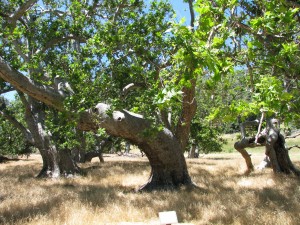
Two-hundred year-old sycamores stunning views of the mountains and hills west, with a glimpse of Palomar Observatory in the far distance

The View towards Palomar Observatory and equally serene pastoral landscapes of mountain homes, apple orchards and rolling hills in the southeast.
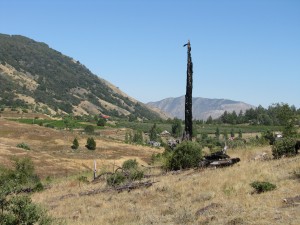
A beautiful valley of apple groves At this time of year the grasslands are pale gold, and ripples travel for acres in the very welcome warm breeze that kept this July day from being overwhelmingly hot.
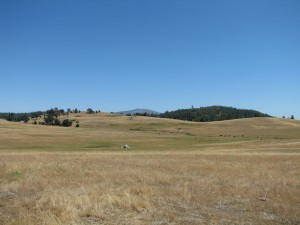
Rolling grasslands A new experience for us was to walk miles of trail while disturbing thousands of grasshoppers that flung themselves out of the way or took wing to avoid us. It was like setting popcorn off as we walked, trying to not tread on any but also being hit by some misdirected fellows. One took a ride on my pants for awhile until he began to investigate my pants pocket and I had to give him a boost to freedom.
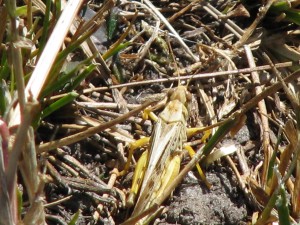
Grasshoppers It was a glorious day for birding; some of the birds we saw were flocks of Western bluebirds, kingbirds, a lark sparrow, a Lazuli bunting, ravens, chipping sparrows, goldfinches, bushtits, both spotted and California towhees, acorn and Nuttall’s woodpeckers, a Northern flicker, a Cooper’s hawk, an American kestrel, Western meadowlarks, brown-headed cowbirds, cliff swallows, Steller and scrub jays, Mountain chickadees, and many turkey families, their brood half-grown and comically awkward. We saw bright red Large Milkweed Beetles on blooming Indian milkweed, a late blooming Summer lupine, and did I mention grasshoppers? Thousands of grasshoppers. Almost the entire hike. A pair of ravens sat in the tall grass to the side of the trail with their beaks open, catching them as they leaped, as did Western bluebirds and others.
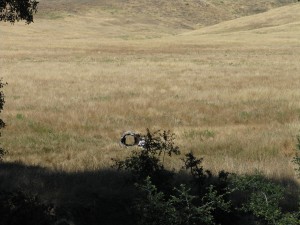
A hollow stump that looks like a TV set The Preserve is also home to cattle, and groups of the little ladies and their offspring dotted the landscape. Many bad cow jokes ensued (they’re in a bad MOOd; you can’t HIDE from them, they are UTTERLY charming, we’ve got to HOOF it past them, let’s MOOve it along… well, you get the picture), and although they watched us warily, they gave us no problem and we spoke to them soothingly as we passed by.
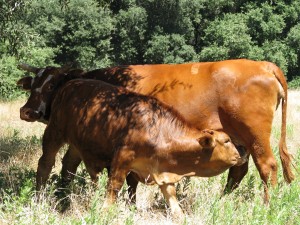
Lunch The Kanaka Loop Trail is easy up to the streambed crossing,

Good run-off for July then it goes uphill in areas which are bare due to elevation and past fires, so there is little cover. Many pines have sprouted up and their fragrance in the heat is intoxicating. However twice during the trail up through the trees we smelled greasy french-fries, and have no idea what plant or combination of flowers created that scent. It is an exceptionally beautiful trail and not difficult for the average hiker, but be sure to take a hat and lots of water, and a good attitude towards cows!
-
Dutchman’s Pipe

Vigorous Vines There are a few very peculiar specimens in my garden, thanks to Roger Boddaert. They have nothing to do with edible forest gardens, drought tolerant plants or permaculture. They simply are fun. One of which is the Dutchman’s Pipe (Aristolochia), named that because it’s very odd buds look something like… well… the pipe a Dutchman might smoke, I’m guessing. I’m thinking that the Dutchman was either blind or drinking heavily to put something that looked like this in his mouth! Another less imaginative name for this variety is Calico Flower. They look like hanging squash when they are immature.

Many buds waiting to open There are many varieties of this vigorous vine, each having different sized flowers. Mine has flowers in Summer and Fall, and they are sizable.

Flower Opening The vines can grow 30 feet high, and the plant can easily cover the side of a house. They originate in the Southern United States, preferring moist soil.

Flower opening more This is the larval host plant for the blue and black pipevine swallowtail butterfly, which don’t migrate this far west. Perhaps something else will find it useful.

Opened flower is flat The flower develops as a miniature version of its large self, and then continues to grow into these sack-like buds. When ready, they fold open to become flat, with the seed pod in the back. The flowers catch the wind and twist on their stems like decorations. Or like those things in the original Star Trek that flew across the cave and attached themselves to Spock’s back. So another fun and kind of creepy plant, which will provide shade, food for butterflies, and a lot of conversation starting. Gotta love it!

The one on the right is laughing! -
Zucchini
I have four vigorous zucchini plants. Why four? Because in winter with a lap full of comforter and gardening catalogs, the January eye peers back at July’s garden and the plants are smaller, the harvest never enough. What if something happens to one spindly seedling? Then there would be no zucchini, and summer without it just wouldn’t be the same. So four tiny sprouts went into the ground and four large plants are what I have. The zucchini harvest began several weeks ago. My daughter and I have happily eaten sauteed zucchini, seared zucchini, broiled zucchini and have even made sun-dried zucchini chips. It has been too hot to make Rosemary Zucchini Soup (see my recipe section). Zucchini bread uses far too little zucchini for the amount of calories it contains. The problem with zucchini recipes is that they use far too little zucchini! Zucchini has many health benefits, and is low-calorie, versitile, and is the butt of many summer-harvest jokes. I say this while considering who I know that I might unload some of the harvest upon.

Zucchini Chips ready to sun-dry on the roof We’ve both been harvesting under the enormous leaves this year’s zucchini plants have produced, and have kept up with it with few surprises. Until today.
In summer the days can run into each other with a speed that is breathtaking. We’d gone two days without checking. Then this morning after a second morning of trying to teach our old dog General the new trick of not hunting the chickens, which we were allowing out of their coop, we were on our way back to the house. It was hot already, the morning mist having burned off as if with an acetyline torch. My daughter carried strawberries in her hat and I was headed up to water stressed plants stranded without irrigation. Then I caught a glimpse of something along the edge of the raised bed. It was green. It was wedged against the corner and pressing against the edge of the wooden end. It was trying to break free. Trembling and exchanging fearsome glances with my daughter, I lifted a spiny leaf: There lay a six-pound zucchini.
This might not impress you. Perhaps you’ve recklessly gone on a summer vacation and forgot to mention to your neighbors that they should keep a cool eye on the big plant in the veg bed, and returned to find a green Moby Dick sucking up all the water in the garden. Perhaps you know already that the world’s record zucchini weighed 65 pounds. The world’s longest was 69.5 inches long, which is 6 and a half inches taller than I. Yet to find a six pounder trying to break down my much-cherished raised bed was something of a shock, especially when there was only a two-day gap between checking. This zucchini is only slightly less weight than my daughter at birth. Yet, I feel strangely deprived of maternal instincts toward it.
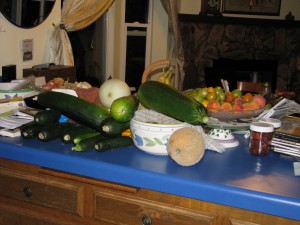
Big Zucchini How luxurious it is to complain about too much food. I’ll make steaks out of this big one, and perhaps donate the smaller ones to the Fallbrook Food Pantry. And begin to harvest the squash blossoms more vigorously!
-
Until Next Week….
I’m about to do the drive from Fallbrook, CA (in San Diego County) to Corvallis, OR again. Almost exactly a thousand miles. I’ll be back home in six days (I’ll be blogging as I go, though!). However, the day before a trip I get a little crazy. I whip myself into a cleaning and organizing fury. Part of it is that I like to come back to a clean house. Part of it is that I have a lot of animals and I want to make sure that they are all as set up as possible with food, water and clean bedding, even though they’ll be taken care of on a daily basis while I’m gone. Part of it is that I get a kick out of multi-tasking and coordinating, and I burn off a lot of pre-travel worry this way. I shop and stock up on animal food, I do laundry, hauling wet sheets and rugs out to the clothes line and back in again. I cook, take out recyclables and trash, pack and blog. I soak and scrub cat and dog dishes, I sweep the walkway (why? I don’t know. It will be gunky by the time I get back), I clean out the last of the honey that is dripping from crushed comb and give the bucket to the bees to clean up. (Straw on the bottom keeps the bees from becoming stuck in the honey and drowning.)

Bees cleaning up honey I water everything. I wash the dogs and their bedding. I leave unnecessary notes.
It is wise to keep out of my way on the day before a trip.
Work will go on in the yard while I’m away. I’ll tune in next week to find out the answers for….
Will the lower pond be filled, and not look like green tea?
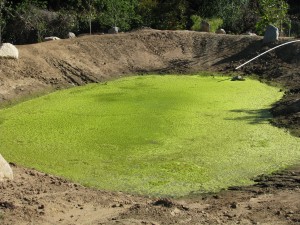
Pond algae Will these palm trunks become a bridge?
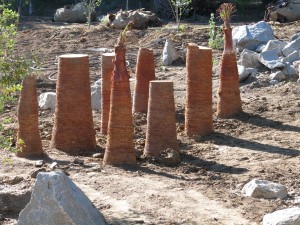
Bridge pilons Will these fancy new stairs made from cement chunks lead to something?

New Steps Will the jasmine hedge still be blooming?
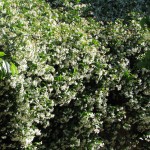
Jasmine Hedge Will the giant sunflower ever look up? Will the vining vegetables take over the property?

Garden Growing Will whatever is eating the stairs leave any to walk on?
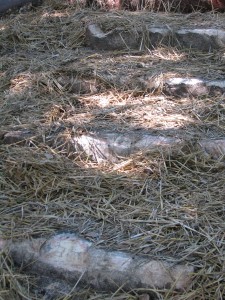
Chewed Steps Will the subterranean irrigation lines be buried?

Irrigation lines Will the kumquats ever get cuter? (Impossible. Too fun a name, to say and to spell. Go ahead, say it: “Kumquat, kumquat, kumquat.” See? Cute name for cute fruit.)

Kumquats These and other questions will (in all probability) be answered next week. Stay tuned for the answers… same bat time, same bat station.
-
A Scream in the Pond
I have a small lined pond in my front yard, created by my daughter and I a good five years ago or so. It is a pond gone native, for the most part, and I like it that way. The mysteries of what lives in those three feet of murky algae-laden water give me a shiver and excite my naturalist sense of curiosity (See post The Monster in the Pond of March 2nd). Sometime earlier this year as I was walking past the stretch of green that was partially covered with newly unfolding waterlily pads, I was startled from my reverie (I’m always in reverie it seems, especially now that I’m wrestling with mid-life crisis!) by what sounded like a small scream and a splash. I saw nothing. Hmm.
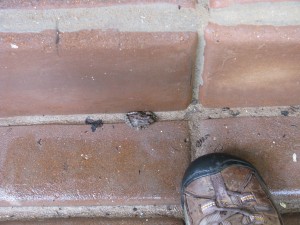
Young Pacific Chorus Frog During the most frigid, god-forsaken unpopular months of January and February, it seems as if every Pacific Chorus frog migrates from a forty-mile radius to mate in my small three-hundred gallon pond. Every night the males attempt to out-sing each other with such buzzes and chirps that even I’m impressed and tempted to follow their siren song, if only it weren’t so cold out there! (Wimpy San Diegan, I know!) Let their large ladies deal with them, I say. Sometimes their song is so loud that it becomes one giant noise. Often it drowns out whatever movie we might happen to be watching and we have to shine a flashlight out the window to startle them, catching them in flagranti as it were and quieting them for a short reprieve.

Pacific Chorus Frogs Taking a Break from Singing However, none of them scream. They sing.
When walking past the pond a few weeks later it happened again. A much louder scream and a splash. At least I knew that whatever it was hadn’t been so frightened by my passage that it committed suicide the first time. Then soon after my son came in from the front yard with a puzzled expression and said, “Something in the pond just screamed at me.”
There is a lot of algae in the pond which blooms about the time the frogs are mating, so I leave the frothy green bunches in place to protect the clear jelly sacks of spawn that cushion the frog eggs. Therefore, not much visibility at any time in my pond. Nope.
Finally I saw the screaming thing as it flung itself from the flagstones into the water. It was a large frog, much larger than the Pacific Chorus Frogs. Uh-oh.
When at breakfast I saw it sitting on the flagstone walkway around the pond through my bay window, my heart sank. It was a bullfrog. The glistening, beautiful green gigantic (for around here) frog sat there for awhile, then leaped into the undergrowth of my columbines.

Bullfrog about to go hunting through columbines American bullfrogs (Rana catesbeiana) are what you think of when and if you ever think of frogs. They can become huge. People farm them to eat their legs and back meat (oh ick!). Little American boys are supposed to spend their idle childhood summers wading through creeks (pro: criks) catching them and tickling their stomachs. I think they are a gorgeous and wonderful creature.
Except. Except that bullfrogs are not native to the Western states and they eat anything that they can shove into their mouths, including snakes, birds, rodents, other bullfrogs…. They are partially responsible, along with the red-eared slider turtles (America’s favorite pet turtle which was dumped wholesale into lakes and streams after the salmonella scare some twenty-five years ago and took over the waterways) and polluted water for endangering our native cute little Western pond turtles. So having this great screaming mouth eating down my mosquito fish, my Pacific Chorus frogs and their young, and everything else in the yard, is not good news in my book. Then my son noticed a second, smaller one. A male. Oh no!

Uh-oh. There's a male bullfrog, too! How to catch a bullfrog? I brought out an old cat litter bucket and a fish net and left them handy. We’d see the frog’s nose clearing the water, but by the time we’d go out there he would be long gone. Being very busy I didn’t have the opportunity to sit, net in hand, for hours waiting for my screaming frog to appear. (Hey, wait, shouldn’t that be ‘handsome prince’ instead of screaming frog? I get everything wrong!).
A few days ago on a sunny afternoon I was surveying the weeds in my garden, trying to burn them into cinders with my eyes without success. I walked along the pathway by the pond that was now almost completely overrun with peppermint, lazy stalks of columbine, the all-too vigorous Mexican primrose and the definately healthy weeds. I surveyed the back half of my garden making plans about weeding that had to be carefully done since many of the nasty little beggers were coming up in my heirloom bulb beds and their stalks looked almost identical.

Big Mama Wandering back I stepped through the overgrown columbine that hid the path when suddenly something big and shiny and screaming came flying up towards my knees from right under my foot. I also screamed and jumped. A second scream and leap to my left alerted me to the very large, very green bullfrog panting and staring at me with much the same expression that I must have been wearing as I stood staring and panting back. Even in my surprised state I realized that this might be my chance. Of course, the bucket was all the way over by the gate. I made a lunge for the frog but she evaded me. I managed to keep her from jumping into the pond and she disappeared under some weeds and mint by the bird bath. I squatted down and held down the grass hoping to contain her. I yelled for my son, but he was out of earshot. I started laughing, which I do so often in my life when I find myself in unusual circumstances. Come to think of it, I laugh pretty regularly. Maybe too regularly. Regaining control of the slight hysteria and my breathing, I slowly lifted up the grass… but she was gone. I knew she hadn’t jumped into the pond. She must have made her way along the sides of the flagstones. I made a plan. Quietly I stood and tip-toed around the back of the pond and around the end, making my way back toward the gate and the bucket with the fish net. Everything was still and I made no noise as I crept along. Just as I made it halfway past the pond, there were two almightly screams in close succession, two jumps and a splash. Fortunately it was the bullfrog who landed in the pond, not me. Shaking slightly with a trace of that hysterical laughter, I went inside to have a calming cuppa tea, and to give the lady frog time to settle her nerves as well. All that screaming had been a very girlie experience for both of us.
-
Skunk in a Can
I worked for San Diego County Parks and Recreation for ten years as a Senior Park Ranger. My first assignment was at Flinn Springs County Park, near Lakeside in East County. Flinn Springs is a small oak-filled park with a stream running it’s length. My year there was interesting and quite a learning curve. I was lucky enough to meet some very wonderful people. One such person was Mel. Mel and his wife, both in their early 80’s, were seasonal volunteers at the park. The volunteer program with the County is a good one for the right people. In exchange for free utilities and a place to park a motorhome or trailer, the volunteer must perform twenty hours a week of service to the park. Some volunteers stay at a park for years. Others, like Mel and his wife, spend six months in our mild winter climate, then head to colder states where their home or family is for the summer and Fall.
Mel was tall and thin in his khaki volunteer uniform. His job was to clean the restrooms in the park every day. That entailed removing all the toilet paper, hosing down the inside (called ‘field day’), scrubbing toilets, and emptying the large aluminum trash cans that stood outside the doors.
Mel and I were talking once, not long before he and his wife would be driving North. He was telling me that at the first restroom that morning, which stood just above the streambed and foot bridge, there had been a young skunk in the trash can. Mel said that he’d looked down into the trash can to see if it needed emptying, and there was this young skunk looking up at him. It gave him a start, but he figured that he’d given the skunk a start, too. He thought that the skunk had been searching for food and had become stuck in the can. Mel addressed him kindly, then very gently tipped over the trash can. The skunk waddled out obligingly and without a backward look or spray, disappered under the footbridge where Mel thought might be the den.
Mel came up to me about a week later and, shaking his head, said that I wouldn’t believe it but every morning he’d look in that same trashcan and the skunk would look up at him. He’d say a few words of greeting to the little fellow then gently tip the can over and the skunk would waddle off. Mel said that he’d enjoyed his morning ritual with the skunk, but since during the week in the off-season there wasn’t anything in the trash can, he wondered why the skunk would get himself trapped into the can like that, morning after morning.
That weekend was the last for Mel and his wife, who were driving up to Minnisota for six months to be with their children. In fact, Mel didn’t even own a house anymore, but the two of them lived in the mobile home and had their furniture in storage. Up in Minnisota they volunteered at another park for the other six months, and this life suited them both just fine. I really liked the pair, who were very lively for octigenarians.
With no volunteers in their space, and being the newest Ranger at the park, I took over Mel’s routine. The morning after they’d left I headed down the hill to the restroom. Not thinking about much, I glanced into the trash can to see if it needed emtying and, lo-and-behold, there was a half-grown skunk at the bottom, pointy nose raised and beady eyes looking at me. I froze and looked at him, and he froze and looked at me. Then I remembered what Mel had told me and I greeted the little fellow. Examining me with his beady black eyes, he appeared to become agitated. Gently I tipped over the trash can and the skunk waddled out and down the embankment to under the footbridge and at a quick rate.
The next morning I smiled to myself as I went down to the restroom to clean, thinking about seeing the skunk again. I looked into the trashcan and… no skunk. I never saw that skunk again.
I guess the game wasn’t any fun without Mel.
-
When Chickens Fly
My seven chickens are quite the young women now. They really should be out in a pen, not still in a Rubbermaid container in the side room, but tractor work will be started this week and I don’t want to horrify them with large machinery. The big girls have begun to squat on the floor like broody hens. Most of their feathers are in and they look very sleek and lovely. The Americaunas, who are almost two week older than the others, are much larger and also much shyer. They are usually at the bottom of the pile when I go in to change their water. Why is it that I’ve held them, fed, watered and cleaned them, crooned to them, and every time I put my hand in there they start screaming and flying around as if I’m going to murder them? I’ve explained my vegetarianism to them, after all!

Lovely Ladies Then there are the two smaller girls, the Barred Rocks. These girls have attitude. They were in a large cardboard box for awhile, but the larger of the two kept jumping up and out. Last week I found that they were in the same container as the larger girls! Apparently they both got out of their own box, had a time pooing on the floor, then went exploring into the big girl’s domain. The Barred Rocks (BRs) were in one corner, and all five of the big girls were dogpiled in the far corner. They were all frightened of each other! (Yes, the term chicken comes to mind here.) I left them for the night thinking that maybe they’d settle in together (no pecking), but heard intermittant squawks. Apparently the Silver Wyandotte would be brave enough to verture over and scare the BRs, then the larger of the BRs would venture over and scare the others. Geez. So I pulled out an old birdcage and put the BRs in it. They like it just fine, and are enjoying the wooden perches. Of course, teaching chickens to perch in trees is not a good idea, but I have experience with this phenomena.

Barred Rock Songbirds About fifteen years ago, me and my young children were living in a house in Vista along a busy steep road. Across that road was a fenced property with avocado trees and a couple of loud Rottweilers. On the corner of my yard was a tall pine tree that stretched past the convergence of telephone wires.
I had the opportunity to aquire some mature hens from my boss who couldn’t keep them any longer. One in particular was a Barred Rock with an attitude. We were novices at chickens, just claiming cats, dogs, fish and tortoises at the moment. The first night the chickens spent in the garage. Chickens after dark are like moaning footballs. Like bees, they don’t fly after the sun falls, and those who would scream and behave as if they were about to be axe-murdered upon your approach in the light, would in the evening suffer you to pick them up and tote them around like inanimate objects. Inanimate except for the low crooning moans of great distress and sadness that chickens use as lullabys.
I built a very large, and in my opinion, handsome cage for them on wheels (a chicken tractor and I didn’t even know it!), and there they lived. We allowed them to roam during the day when we were home. Then we found that one of the Barred Rocks, and I’ll give her name to you now as DC although that sobriquet was bestowed later, enjoyed flying up to the lowest limbs of the great pine tree. I’d never heard of chickens flying. There are, thankfully, no chicken migrations darkening the sky across the Southwest. If you haven’t seen a chicken for awhile, take a gander at one (oops, wrong fowl) and notice how round and large they are. They are not sleek, flying birds. The BRs, mostly black with white dabblings all over them, look especially rotund and solid, like cast iron. My children and I thought that DC aiming for the heights was, at first, funny.
Then came the day that I went outside to find that DC had set and acquired goals for herself, and had fluttered branch by branch up the pine tree until she was very high up indeed. We tried to lure her down with food and endearments. My son attempted to climb up after her. DC, the most ornery of birds, instead of retreating into the waiting arms of my son, decided to fly. Her first flight was a brief one, more of a fluttering really, to the telephone wires that lined the busy street. There she sat, proudly swaying back and forth on the slender line. If you haven’t seen a chicken on a telephone wire, you really can’t imagine what it looks like. It isn’t like seeing a hawk or another large bird, because they are shaped the way they should be. A chicken, as I’ve said, is like a dark super-sized soccer ball balanced on a wire as if ready to drop any moment. They shouldn’t be that high. I think only seeing an ostrich on a telephone wire would look as strange. The vehicles that came speeding down that hill slowed and made careful detour around the area where she might land if indeed she did drop and shatter their windshields. DC appeared to be about to break her neck, and at this point I was saddened at the thought that it would be her own machinations and not my two hands that would do the act.
My thought now was to get her to fly, or rather drop, back into the fenced area of my property. I don’t remember what time of day it was, but I was dressed in my Park Ranger uniform and badge. There I was, on the far side of the two-laned road in uniform, dodging and directing and apologizing to drivers, an armful of pine cones at the ready, chucking them as high as I could at DC. I am a poor pitcher and none of them came close. However the shouting, the chucking, the passing vehicles and the breeze all made DC come to the decision that she was, indeed, a flying chicken. With grace she launched herself. Chickens don’t fly, but they will, if the wind is willing, glide. She passed unsteadily over the road, causing the driver of a pickup truck to swerve as he caught sight of the immense black object bearing down on his windshield. She just hit managed the top rail of the neighbor’s chainlink fence before teetering over and falling into their yard of avocados.
Dropping my armful of pinecones, saying unpleasant things under my breath, I went to knock at the door of the house who now had a new kind of bird in their yard. No one was home. I’d never met these people, and had only come away with a feeling of slight hostility from them. I went around to the gate in their chainlink fence and the lock was on it but unlatched. Closing the gate behind me I ducked under and around the variety of fruit trees, calling for my lost pet, hoping that the inhabitants of the house were not just lunching on the back porch with their rifles handy. I caught sight of DC, who looked no worse for wear but a little flustered by her adventures and in no mood to suddenly become docile and walk over to me. At the same time that I caught sight of her, I stepped in a pile of poo. A very large pile of poo. That’s when I remembered the Rottweilers.
I froze, listening. I hadn’t heard any barking, not even when I knocked at the front door. That could mean that the huge unfriendly dogs were on the back porch with their huge, unfriendly owners, and all of them had rifles. And as DC headed around the back corner of the house, I thought I’d pause and see what happened before I lost my direct pathway to the side gate.
After no explosions of ammunition or feathers occurred, I went after her. Bent over to avoid branches, hissing so as not to draw attention to myself, chasing her around in circles because chickens are the most uncooperative of animals, I finally cornered her. I threw a stick so that it landed behind her, and scared her enough to run towards me. I grabbed. She screamed and fussed as I ran with her tucked under my arm, not unlike a football, back across the street to the safety of my own yard.
It was afterat we began to clip her wing feathers,, and it was then that she earned the name of DC, which stands for…. Damned Chicken.
-
Genetically Modified Foods, and a curious, unrelated photo
Genetically modified food (GMs) are what happens when scientists manipulate cells or even nuclei by inserting genes or viruses to change the DNA. Before GMs farmers would hybridize plants by breeding for preferred character traits. GMs may or may not cause damage to human DNA, but it’s use has escalated the use of pesticides, herbicides and animal cruelty. Since Monsanto, the makers of the herbicide Roundup(tm) are also the leaders in GM food, it seems that they are lining their own pockets by selling products for both cause and effect. If eating GM food is something you’d rather not do, I have just come across a useful article that might help. In the April/May, 2011 Vegetarian Times, there is an article by Neal D. Barnard, MD on the subject. In the article he reveals that manufacturers in the U.S and Canada aren’t required to label GM food. However he says that most US-grown corn, soy, cotton, Hawaiian papaya and canola is GM, but most other fresh fruit or vegetables aren’t, such as apples, oranges, bananas, broccoli. (These, however, are often heavily sprayed with pesticides and need to be washed before eating. The Environmental Working Group http://www.ewg.org/ updates a Dirty Dozen and Clean Fifteen list of produce that is effected most or least by pesticides; you can see that list here: http://www.healthyreader.com/2008/05/13/12-most-contaminated-fruits-and-vegetables/ .)
Dr. Barnard goes on to give these interesting tidbits: The labels on fresh produce carry a four-digit standardized code for cashiers to look up the price of the item, called a PLU (price look-up). If the code is preceded by an 8, it is genetically modified. If preceded by a 9, it is organic, and organics cannot be genetically modified. So watch your tofu packages if you don’t want GM soybeans.
Since becoming a vegetarian some sixteen years ago, I’ve been a label reader (even now when it requires pulling out my glasses or holding a can at arm’s length!). The amount of sodium in foods is outrageous, as is the amount of sweetners such as corn syrup. High amounts of salt and sugar is in there not for taste, but for its addictive qualities. When you eat salt or sugar, just like drinking caffeine, you crave more. As a vegetarian, it’s amazing what meat products are slid into foods, even those toted to be vegetarian. Now there is a more dangerous enemy than bad nutrition in packaged food. In my opinion, it is that of GM food and heavy herbicide and pesticide use. Even more reason to shop locally and organically, or to grow as much food as you can, and read all the labels. I am an ethical vegetarian, meaning that I decline to eat animals because I am protesting their horrible treatment and slaughter. GM animals are bred to continuously give milk, to grow enormous, to provide more of what humans eat off of them, despite the physical agony it brings. That coupled with already nightmarish living conditions is a monsterous state of affairs. Then humans injest the modified DNA, the herbicides that the animals eat that was sprayed on their food, and the pesticides that was sprayed directly on the animals. It is not a practice of which I will be a part.
Okay, I’m stepping off my soapbox now. As promised, I have a curious, unrelated photo. I have to balance reality with humor to keep sane This was taken by my daughter as we left the area on our recent Oregon sojourn, and we ask ourselves, “Huh?” A really big blowhorn faced the wrong way? A jet engine, faced the wrong way? A hood ornament…. faced the wrong way? Something unusual that fell out from under the car? A neutron accelerator? I love the care of placing a skid under the thing to protect the hood, but cinching the straps so tightly it dents the sides! Another funny incongruency in life, which keeps that humor in living. Any suggestions as to what? Or better yet, why?

Hood Ornament 
Horn? -
The Monster in the Pond
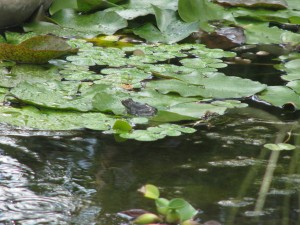 Ok, ok, I’ll succumb to popular demand and tell my pond story. A number of years ago I came into possession of free pond liner and flagstone. My daughter and I hacked down a juniper that had taken over our front yard, pickaxed out all the roots and rocks, and after watching many YouTube how-to videos, built our Perfect Pond. I indulged in waterlilies, a priceylotus, and some other cute little water plants. We set free a few mosquito fish, and enjoyed our organic water feature. Well, it was better than we ever thought. It attracted birds, dragonflies, and Pacific Chorus Frogs. In fact, in early February, every frog in the county makes its way over to our little 400 gallon pond and begins their mating calls. They are so loud that we’ve had to shine a flashlight out the window at night to quiet them down to hear a movie! Soon we had evidence of amphibian genetic success.
Ok, ok, I’ll succumb to popular demand and tell my pond story. A number of years ago I came into possession of free pond liner and flagstone. My daughter and I hacked down a juniper that had taken over our front yard, pickaxed out all the roots and rocks, and after watching many YouTube how-to videos, built our Perfect Pond. I indulged in waterlilies, a priceylotus, and some other cute little water plants. We set free a few mosquito fish, and enjoyed our organic water feature. Well, it was better than we ever thought. It attracted birds, dragonflies, and Pacific Chorus Frogs. In fact, in early February, every frog in the county makes its way over to our little 400 gallon pond and begins their mating calls. They are so loud that we’ve had to shine a flashlight out the window at night to quiet them down to hear a movie! Soon we had evidence of amphibian genetic success.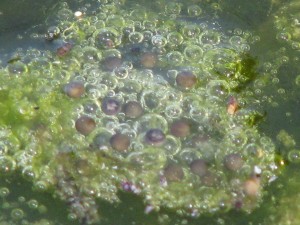
Frog spawn! Then tadpoles, and tiny frogs that mostly disappeared somewhere until the following February. The mosquito fish found similar romantic success and soon numbered in the hundreds.
Other than giving the non-human youth a Lover’s Lane, as it were, the pond had its ups and downs; the raccoons just loved getting in and knocking over the expensive lotus plant, so it never flourished. Some very creepy flat-headed black wormy things appeared in the filter, the dragonfly larvae looked like the stars of B-movies in miniature, and some of the plants tried to take over the world. After a few years, I decided that there was too much plant growth and it needed to be thinned out. With rubber gloves on hands and an explorer’s enthusiasm, I went in. (Oh, and by the way, NEVER put pea gravel in your pond, no matter how many people say to on the Internet or in books. It’s too sharp to stand on, it can wreck your liner with its pointy edges, and it makes a dead biomass on the bottom of your pond. Thanks, I had to say it. I hate pea gravel. That’s my rant for the night.)
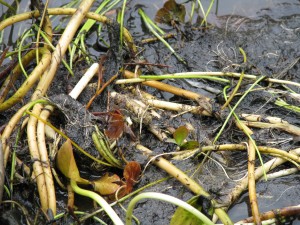
So I was doing all right, standing in my knee boots, groping around under the murky water pulling and untangling long root and stem systems of these too-happy plants, when suddenly…. I felt something. Something that wasn’t right. Something that was too large to belong in our little pond with its one gallon happy plants in it. Something that felt long and nobby like a huge slimy neckbone. A monsterous, nobby, slimy neckbone.
Now, I’m not a squemish person, nor one to back down at a challenge, but this THING was so not right that I was dropping it and getting my boots out of that pond pronto. After watching to see if it had followed, and satisfied that it hadn’t taken offence, I decided on perhaps an abridged version of the ten-foot-pole ploy, and used a rake to gently heave it out of the water. It was all tangled up in my wonderful waterlily leaves, so I tried to untangle as gently as I could, crooning soothingly to it as I worked. Then, to my horror, I discovered that …. the monster neck WAS my sweet little waterlily! How could that have happened? In only three years!
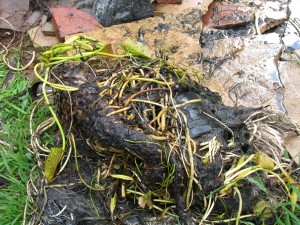
The one gallon black plastic pot had apparently fallen over (thank you, racoonies), and this plant wasn’t going to wimp out like the lotus. Ohhhh no. It grew out of the pot and made a U-turn heading back towards the light. The neck was about 3 inches in diameter, about the size of a human’s, I’m guessing, but more alien. Observing the true underwater nature of my waterlily made me feel like Rosemary of Rosemary’s Baby fame: my little darling was a slimy hideous monster. So, I did the only rational thing I could think of. I shoved the whole darn thing back into the pond, prodded it with the rake (the plant grabbed the tines, I know it did!) until I couldn’t see it anymore (the arch of the neck kept protruding from the water surface! I had to almost beat it underwater). Then I went in the house and had a hot bath to get the slime and smell off of me, and try to recooperate. You bet I locked the doors.
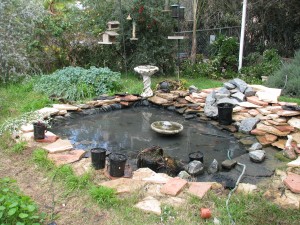
In conclusion, the invasive pond plants were ripped out, I exchanged some water to help keep the biomass alive, and I learned something about myself. I’m not afraid of black widow spiders, snakes, heights, caves, or blood. I am, however, afraid of two things. One has been a long-standing fear of high-school-aged students, dating back to before I even was one, and I don’t think anyone will challenge me on that one. The other thing I’m afraid of is that waterlily in my pond. Its been several years now since this incident, and under the water its been growing… growing…. I haven’t waded back in there since.
